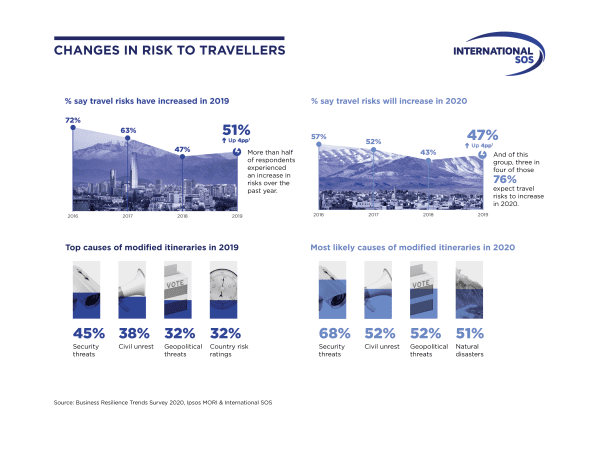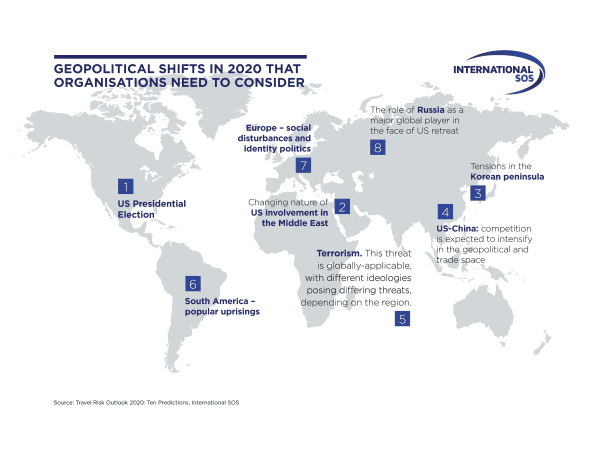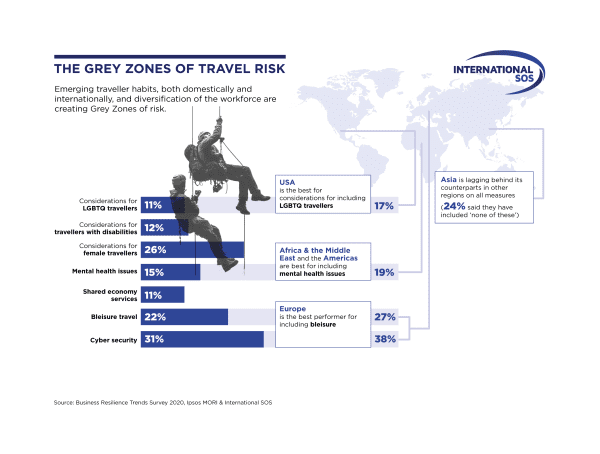The Travel Risk Outlook 2020: How can organizations ensure safety of traveling employees

In 2020, global mobility has become mainstream and almost every organization in the world, big or small, is venturing everywhere to conduct business. But given the complex global geopolitical and climatic situations, the risks from globalization to businesses have also increased manifold.
Just as foreign direct investment inflows in different countries have increased, the economic impacts of global risks are rising too. The Travel Risk Outlook 2020 research by International SOS, leading medical and travel security risk service company for corporate employees, reveals that non-communicable diseases are predicted to result in a cumulative lost output of $47 Tn between 2011 and 2030. Similarly, the costs of extreme weather events regularly exceed $1 Bn.
As per Arnaud Vaissié CEO, International SOS, thus the key challenge facing organizations is not to be so preoccupied with global opportunities that they lose sight of their Duty of Care to their people. Organizations need to strengthen their resilience to ensure continued operation and survival in the face of risks while ensuring their employees are safe.
Global Businesses, Global Risk
As businesses go more global in 2020, the risk outlook is ever-evolving, and so should the preventative and protective approaches of organizations.

As per the Travel Risk Outlook 2020 research by International SOS (based on original research conducted by the Ipsos MORI Corporate Reputation team, as well as supplementary research ‘pillars’ which draw on International SOS’ case data and on-the-ground intelligence), noteworthy predictions for travel-related risk for organizations in 2020 are-
• Risks borne from geopolitical shifts will be the most important mobility challenge for businesses in 2020. More than half of organizations surveyed (52%) believe geopolitical threats and civil unrest will be among the most likely causes of modified travel in 2020.
• Climate change will exacerbate the occurrence of environmental disruptions in 2020. Half of the organizations (51%) believe that natural disasters will be among the most likely causes of modified itineraries in 2020.
• Infectious disease outbreaks from established and newly emerging pathogens will increase in 2020 due to multiple factors, including climate change, increasing urbanization, diminishing vaccination coverage and security instability.
• Bleisure travel: The debate whether an employer is responsible to cover bleisure as part of employee Duty of Care will amplify in 2020. Yet only 22% of organizations include ‘bleisure travel’ in their travel policies. Compared to other regions, Europe is the best performer for including this (27%).
• High profile Duty of Care legal cases will increase in 2020. This would mean that there will be a greater focus from organizations and employees around their Duty of Care in order to mitigate risk for companies and to make it an attractive place to work
• Startups and SMEs that are under-resourced and inexperienced will struggle to meet Duty of Care obligations in 2020. Because small-medium sized companies are less aware of the issues and potential risks and threats and are also less able to invest in systems to help manage these.
The report further adds that the unifying trend behind why geopolitical shifts are seen as so risky to travelers is due to the general sense of instability, unpredictability and speed of change in this space. Issues such as increased terrorism, elections and associated instability, and relations between states (e.g. US, China, Russia, Middle Eastern countries) will be major geopolitical risks that organizations need to consider.
 In order to deal with the uncertain geopolitical landscape in 2020, organizations should seek to understand which of these are most likely to impact them. This should be based on their industry and geographic exposure to such areas. They should analyze and plan travel and business based on the risk the events may pose to them and their people.
In order to deal with the uncertain geopolitical landscape in 2020, organizations should seek to understand which of these are most likely to impact them. This should be based on their industry and geographic exposure to such areas. They should analyze and plan travel and business based on the risk the events may pose to them and their people.
Similarly to deal with risk associated with natural disasters, to protect the safety of their mobile workforce, organizations should also ensure that employees travelling to or based in areas at risk from natural hazards should be briefed on what to do in the event of an emergency, and understand the support available and its limitations.
 What can you do as responsible organizations to mitigate travel risk for employees?
What can you do as responsible organizations to mitigate travel risk for employees?
It is clear that an organizations’ role in mitigating risk for travelers will increase in 2020. Not only there is a need for organizations to recognize an increasing awareness of Duty of Care, but also to provide more training, information, preparation and communication. In addition, it also needs to be clear where the employers’ Duty of Care begins and ends.
Neeraj Balani, Managing Director, International SOS India says, “Geopolitical instability, social and civil unrest, coupled with climate change will be a crucial disruptor in 2020 for traveling employees. We can already see the impacts of such activities in various countries around the globe, including India. This is also expected to give rise to multiple travel and medical challenges for the companies. Hence, it is time for organizations in India to realize the need to ensure responsible employee travel policies and identify potential risks in advance that adhere to not only to Duty of Care obligations but also to optimize risk management costs, to ensure safer business travel in 2020.”
As responsible employers, you can-
• Clarify and communicate your policy: Decide whether or not you will cover travelers on leisure travel, and/or if they extend a work trip
• Provide resources to your employees: Ensure that your employees have access to learn about the risks in the destinations to where they are headed and can access alerts for their destination. This can be useful in understanding areas to book accommodation, which places to avoid on their free time, to identify appropriate modes of transport or to stay apprised of any changes to the risk landscape while they are in a country such as demonstrations, terrorist attacks, natural hazards.
• Where possible, capture travel itineraries: Organizations could make sure employees are forwarding their personal travel itineraries or uploading them to corporate tracking tools (if available), or at least can proactively notify the organization where they are (mobile check-in).
• Keep updated emergency contact information: If unsure about whereabouts of an employee after they have concluded the business travel portion of their trip, ensure you can reach out to someone who knows where they might be.
• Assist first, cover costs later: If you have an employee in need of urgent, emergent care or assistance, and you are able to assist, provide them with the resources to help as a priority; whether the costs will be covered by your organization can be discussed after the situation has stabilized.

















